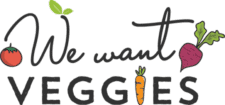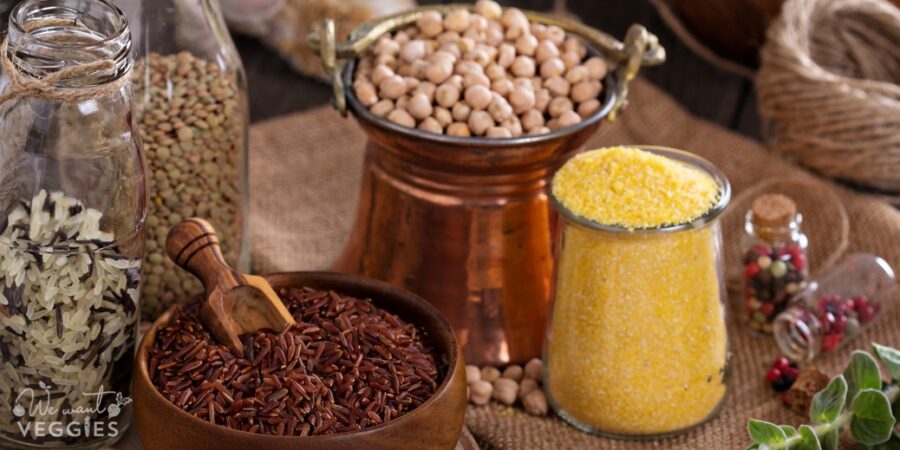A typical plant-based kitchen includes a variety of kitchen staples from beans and grains to vegetables, nuts and non-dairy milks. In this post, we will take a look at many of these common pantry ingredients in detail.
Looking specifically at your own pantry, start by stocking a variety of beans such as black, chickpeas, lentils, cannellini, etc. Beans are excellent sources of fiber, folate, protein, iron, vitamin B1, and minerals. Because they are so practical, most people reply on canned beans for every day use. With that said, there are a lot of great reasons to choose dried over canned. First and foremost, you’ll save money and reduce waste when you use dried beans. Moreover, you’ll have more control over how much seasoning, such as sodium, you put in your own beans. For these reasons, I usually like to keep my own kitchen stocked with a combination of canned and dried beans.
Next, stock your pantry with a variety of grains. Choose whole grains such as rice, quinoa, polenta and oats. If you’re not concerned about gluten, consider adding couscous and farro. While your typical all purpose white flour is plant-based, it’s not all that nutritious. For optimum health, replace your all purpose flour with whole grain flours such as whole wheat or spelt flour. If you enjoy pasta, be sure to keep a variety of shapes handy for use in pastas, soups and salads. While you’re stocking your pantry, don’t forget to check out the international aisle at your local grocery store. Rice noodles and udon noodles deserve a spot on the shelf!
For cooking, trade in your butter for healthier oils. Of course, some oils are still better than others. When possible, choose extra virgin olive oil for sautés, sauces, dressings and baking. For grilling or frying, canola oil offers a neutral flavor and a high smoke point. You may also want to have smaller quantities of toasted sesame oil and coconut oil handy for specific dishes that benefit from the wonderful flavors they impart on the final product.
One thing you’ll quickly learn is the versatility of raw nuts. These can be used to make creamy sauces, replace cheeses, create spreads and add body to soups. In addition, you can toast them and throw them on any variety of dishes for a little protein kick and flair. Common pantry staples here include cashews, almonds, peanuts, walnuts and pecans. In addition, consider keeping a variety seeds on hand—sunflower, pumpkin, sesame, chia and/or flax.
Keep a variety of vinegars on hand for dressings, marinades and sauces. When selecting an apple cider vinegar, opt for a raw vinegar with the mother. With respect to balsamic vinegar, you have a few options. You’ll find both lower cost commercial or condiment grade balsamic vinegars and more expensive aged traditional vinegars. Oftentimes, you’ll see traditional vinegars labeled by the region. Examples include di Modena or di Reggio Emilia. Commercial grade vinegar tends to be a bit milder in flavor with a thin liquid texture. In contrast, traditional aged vinegar tends to be deeply flavorful with a thick and glossy texture similar to that of a balsamic reduction. Keep commercial grade vinegar on hand for dressings, and use aged vinegar for dipping and drizzling. Going beyond these options, consider keeping white wine vinegar, red wine vinegar and sherry vinegar on hand.
While you’re at it, be sure to stock your pantry with liquid condiments as well. Consider Bragg’s liquid aminos, barbecue sauce, deli mustard, salsa, peanut sauce, salad dressing & marinara sauce.
At this point, I’ve been cooking plant-based meals for almost 15 years. If there’s one thing I wish I would’ve started doing sooner, it would be experimenting with the spice rack. Over the years, I have fallen in love with a variety of ethnic cuisines and spices of all kinds. At a minimum, I recommend having the following spices on hand at all times: bay leaves, basil, black pepper, cayenne, chili powder, cinnamon, cumin, curry powder, garlic powder, onion powder, oregano, paprika, salt, sesame seeds, thyme and vanilla. As you advance, you’ll start to add more spices to your repertoire.
Nutritional yeast, or “nooch”, is often used as a substitute for cheese in plant-based cuisine. Nooch offers a nutty, tangy flavor that is somewhat similar to parmesan cheese. As a complete protein and common vegan substitute, suppliers often fortify nutritional yeast with vitamin B12. You’ll find nutritional yeast in both flake and powdered form. Flakes are great for cheesy sauces, but I recommend keeping powdered nutritional yeast on hand to top pizzas, pasta & popcorn.
So, there you have it. What are you going to bring into your own plant-based pantry?


